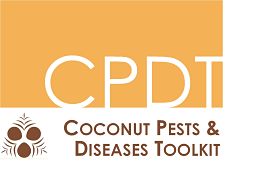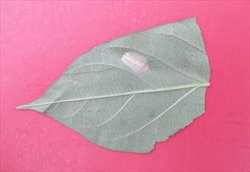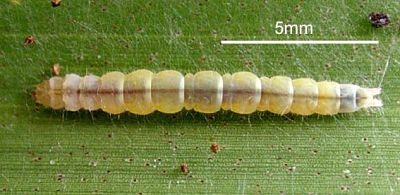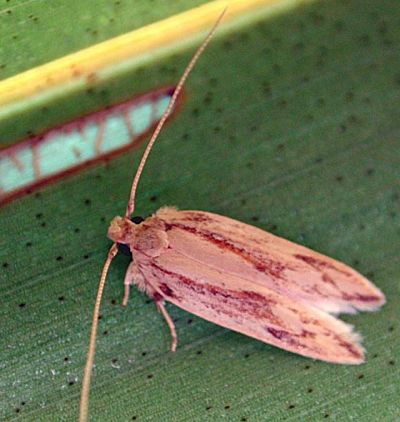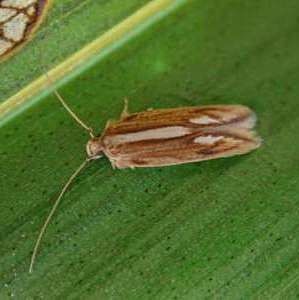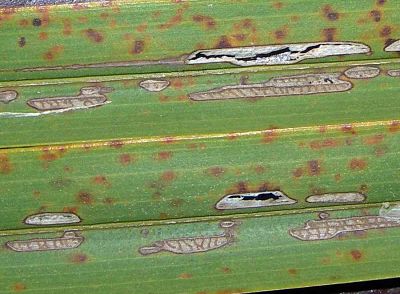Coconut flat moth
Coconut flat moth is a major pest insect of coconut within the Pacific. There is a high risk of outbreak where it occurs. Dry weather increases the abundance of coconut flat moth.
Common nameCoconut flat moth |
Scientific nameAgonoxena argaula |
on this page: Life-cycle and identification : Symptoms : Impacts : Distribution : Prevention : Controlling Coconut flat moth : Information sources and further reading
Life-cycle and identification
Moths are similar to butterflies. There are two Agonoxena coconut flat moth pests that are found in the Pacific region: Agonoxena argaula and Agonoxena pyrogramma. However, A. argaula is more widespread and causes more damage.
The coconut flat moth, like all moths and butterflies, undergoes a complete metamorphosis. The young are commonly called larvae or caterpillars.
The four stages of the moth life-cycle are egg, larva, pupa and adult. Often moth eggs are difficult to find and their larvae are difficult to identify. Identification of adults is much easier but adult flat moths are quite hard to find, and the damage the moth causes is the most distinctive way to identifying insect's presence.
Eggs : Larvae : Pupae : Adults
EggsEggs can be laid singularly (by themselves) or in rows. The eggs are found o n the underside of leaflets near the tips and midribs. LarvaeCaterpillars of coconut flat moths are pale yellow to green in colour, thin and flattened, and when mature can reach 2 cm in length. The larvae of Agonoxena pyrogramma are inconspicuous when they are in their silk web shelters, and much smaller than the 2 cm quoted here. The larvae can be seen feeding on the underside of leaflets next to the veins under a fine transparent web-like shelter they have spun. The caterpillars may drop to the ground or move backwards and forwards when they have been disturbed while in their shelter. PupaePupation occurs on the leaflets or in undergrowth. The mature larva spins a white web around itself before pupation. |
Coconut flat moth eggs on the underside of a sweet potato leaf (© PesNet)
Coconut flat moth larva (© Gerald McCormack, Cook Island Biodiversity & Natural Heritage) |
Adults
Adults are 5-9 mm long and have long antennae.
Adult females (below left) are yellow-brown in colour with reddish brown markings.
Males (below right) are slightly browner than females.
Males have a white stripe down the top of their wings, and additional white spots near the end of the wings.
|
Adult female coconut flat moth (© Gerald McCormack, Cook Island Biodiversity & Natural Heritage) |
Adult male coconut flat moth (© Gerald McCormack, Cook Island Biodiversity & Natural Heritage) |
Symptoms
|
The damage of coconut flat moth is distinctive and is probably the easiest way of diagnosing the presence/absence on coconut. Usually there are only a few larvae and pupae present at any time, so they are difficult to locate and identify, but the damage from previous generations of moths is highly visible. The caterpillars of the flat moth do the damage by eating the lower surface of the leaflets. They eat the tissue of the leaf, making light grey lines 1-2 mm wide and 2-3 cm long that expose the leaf skeleton, near the mid-rib. If there is a lot of damage the leaves will separate away from the midrib in many cases. Look for damage on middle aged leaves that has then progressed to the older leaves. |
Caterpillar feeding resulting in light grey lines or "windows" with exposed leaf skeleton (© PestNet) |
Leaves look unhealthy and dry and under severe prolonged attack palms may die. During outbreaks, 40% of the leaves may have damage.
Nut reduction in mature palms and seedling growth may also be a symptom.
Impacts
Introductions to new new areas and outbreaks of the coconut flat moth can have severe impacts. Within the firstyear of symptoms in Rarotonga, the damage spread throughout a 2 km2 plantation. Substantial damage is suspected to reduce yields and seedling growth slowed.
It is not fully known what percentage of Agonoxena argaula damage causes these impacts within plantations. However, a 20% reduction of nuts has been reported from 25% leaf damage in caged palms in Fiji.
Experts consider that the impact of flat moths is much more significant when palms are also damaged by other pests such as CRB, as there is a cumulative effect of loss of photosynthetic area on productivity.
Dry weather increases the abundance of both species, possibly due to the reduction of their natural predators. This can lead to outbreaks.
Distribution
Please check with your local biosecurity / quarantine or SPC for up-to-date distribution information.
The coconut flat moth has a narrow distribution within Oceania and the two species have non-overlapping distributions.
Agonoxena argaula is recorded from American Samoa, Cook Islands (Southern), Fiji, Kiribati, Nauru, New Caledonia, Niue, Tokelau, Tonga, Tuvalu, Hawaii, Vanuatu, and Wallis & Futuna.
Agonoxena pyrogramma is recorded from Federated States of Micronesia, Guam, Northern Mariana Islands, Papua New Guinea, and Solomon Islands.
Prevention
Most importantly, the International Guidelines for transfer of coconut germplasm should be strictly followed to prevent pests and diseases being moved to new locations.
Good biosecurity is the only way to prevent Coconut flat moth from entering in new locations.
Movement of plant material out of coconut flat moth infested should be prohibited or strictly controlled
For general information on preventing pests and diseases of coconut, see the Prevention section.
Controlling coconut flat moth
We strongly recommend an integrated pest management (IPM) approach to the control of all insects, where possible. This is a combination of methods (pesticides, physical controls such as site hygiene, and biological controls) to minimise the use of pesticides and minimise the cost of control.
Integrated Pest Management (IPM)
The goal of IPM is to keep pest populations to a level below which they cause economic harm. IPM involves using multiple control options together for the economic control of pests (i.e. cultural, natural and chemical).
In an agricultural context the Food and Agriculture Organization defines IPM as "the careful consideration of all available pest control techniques and subsequent integration of appropriate measures that discourage the development of pest populations and keep pesticides and other interventions to levels that are economically justified and reduce or minimize risks to human health and the environment. IPM emphasizes the growth of a healthy crop with the least possible disruption to agro-ecosystems and encourages natural pest control mechanisms".
Cultural
There are no specific recommendations for the coconut flat moth. Keeping plantations clean and ensuring proper nutrient levels may assist palms to recover from coconut flat moth outbreaks, and reduce the likelihood of outbreaks.
The entire life-history occurs within the canopy area of the palms. Removal of plant material around palms may have a negative effect if it decreases nectar resources for those parasites which attack the flat moth larvae and pupae.
Natural
Natural control methods (parasitic insects and natural predators) are recommended and should keep moth populations down.
Parasitoid wasps have been introduced from Fiji, India, Indonesia, Papua New Guinea and Samoa, to attack the caterpillar and pupa of coconut flat moths. These include; Brachymeria QQMP, Bracon QQFiji, Eupelmus QQMP, Hockeria QQMP and Trichospilus diatraea.
Other natural predators may be ants that eat the eggs and kill pupae and spiders which attack the adults of A. arguala. This are likely to be the same for A. pyrogramma. However there is limited information on these. A parasitic tachinid fly was used in Solomon Islands to control the moths but limited information is available.
Care must be taken with the introduction of bio-control agents to ensure they only attack they attack the moth pest and not other (beneficial) insects. Another problem with poorly controlled introductions of bio-control agents is that many agents may be introduced along with hyper-parasites (parasites of the bio-control agents) which greatly impact on the success of the bio-control agents.
Chemical
Indiscriminate use of insecticides is not recommended. Insecticides (synthetic pyrethroids) can be used on seedlings in a controlled environment (i.e. within nurseries) but these will kill natural predators and parasites.
Insecticide use on mature coconuts is not recommended even during outbreaks.
Insecticides are likely to kill natural enemiesof the moth (biological controls) making them ineffective, they are also difficult to apply and expensive.
Information sources and further reading
Bradley. 1966. A comparative study of the coconut flat moth (Agonoxena argaula Meyr.) and its allies, including a new species (Lepidoptera, Agonoxenidae). Bulletin of Entomological Research 56: 453-472. [ONLINE]. This is an excellent paper that thoroughly documents all four Agonoxena flat moths. The paper includes identification keys for every life history stage except eggs, so it is possible to identify species from even the shed pupal skin for example.
McCormack. 2007. Cook Islands Biodiversity Database; Coconut Flat-Moth. [ONLINE]
PestNet, 2017. Coconut flat moth. [ONLINE]
Waterhouse. 1997. The major invertebrate pests and weeds of agriculture and plantation forestry in the southern and western Pacific. AClAR Monograph, 44, 99. download 22 MB.
content reviewed by David Britton, Department of Agriculture and Water Resources, Australia, July 2018; Bob Macfarlane, Solomon Islands September 2018
